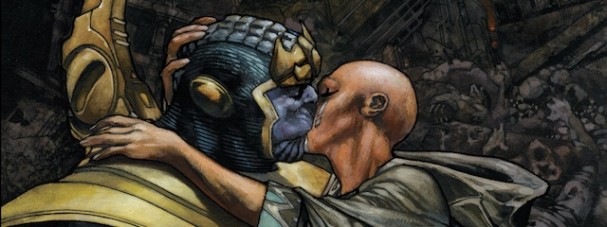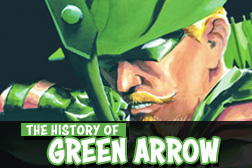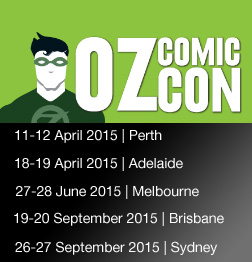Don’t have time for full reviews of comics? Then check out Graphic Bits: bite sized chunks of comic book goodness designed to get behind the panels and into your hearts.
This week (28 August 2013) at Captain Marvel #15 and New Avengers #9 (both Marvel) tie into Infinity, Image brings back Lazarus and Sex, and the ballad of a teen Titan concludes in Thanos Rising #5 (Marvel). Or does it? This is Graphic Bits.
There’s also a separate Graphic Bits this week reviewing the major DC titles: Justice League #23, Batman Incorporated Special #1 and Batman/Superman #3.
Captain Marvel #15 – Marvel, Kelly Sue DeConnick, Jen Van Meter (writer), (artist). Rating: 6/10
 There is something vaguely frustrating about the latest Captain Marvel. While DeConnick and Jen Van Meter (Hopeless Savages) do a wonderful job of crafting a post-trauma Carol Danvers, unless you are reading a number of other books there is still going to be a tremendous sense of having missed out on something. Following Carol’s heroic sacrifice at the end of Captain Marvel #14, she permanently destroyed the extra lobe that made her special, taking with it her memories of her avenging adventures. This makes for an interesting dynamic with her team-mates, who she no longer feels any affinity to in times of crisis. The problem this issue faces is the same as Avengers Assemble #18 last week: Carol’s memory loss is now just the status quo, with no internal build-up or lead-in to the “Infinity” crossover at all. While this tie-in at least acknowledges the events of that mammoth crossover, as well as “The Enemy Within“, it puts Carol’s personal journey on hold for a story that could have been (and partially is) told in the pages of Avengers and Avengers Assemble. DeConnick keeps reminding us that Carol “feels nothing”, so it is difficult for us to know how to react. The big reveal on the final pages will undoubtedly make the story more Carol-centric next issue, but even this is undercut by character’s narrative being dwarfed by the wider events. Veteran Patrick Olliffe gives Captain Marvel the big art and epic grandeur that it deserves, tightly controlling the often chaotic nature of space battles. Perhaps it is simply that up until now, Captain Marvel has been a very personal journey about one of Marvel’s most interesting characters, and this issue demonstrates that there is a danger of her being lost in the noise.
There is something vaguely frustrating about the latest Captain Marvel. While DeConnick and Jen Van Meter (Hopeless Savages) do a wonderful job of crafting a post-trauma Carol Danvers, unless you are reading a number of other books there is still going to be a tremendous sense of having missed out on something. Following Carol’s heroic sacrifice at the end of Captain Marvel #14, she permanently destroyed the extra lobe that made her special, taking with it her memories of her avenging adventures. This makes for an interesting dynamic with her team-mates, who she no longer feels any affinity to in times of crisis. The problem this issue faces is the same as Avengers Assemble #18 last week: Carol’s memory loss is now just the status quo, with no internal build-up or lead-in to the “Infinity” crossover at all. While this tie-in at least acknowledges the events of that mammoth crossover, as well as “The Enemy Within“, it puts Carol’s personal journey on hold for a story that could have been (and partially is) told in the pages of Avengers and Avengers Assemble. DeConnick keeps reminding us that Carol “feels nothing”, so it is difficult for us to know how to react. The big reveal on the final pages will undoubtedly make the story more Carol-centric next issue, but even this is undercut by character’s narrative being dwarfed by the wider events. Veteran Patrick Olliffe gives Captain Marvel the big art and epic grandeur that it deserves, tightly controlling the often chaotic nature of space battles. Perhaps it is simply that up until now, Captain Marvel has been a very personal journey about one of Marvel’s most interesting characters, and this issue demonstrates that there is a danger of her being lost in the noise.
Lazarus #3 – Image Comics, Greg Rucka (writer), Michael Lark (artist). Rating: 8.5/10
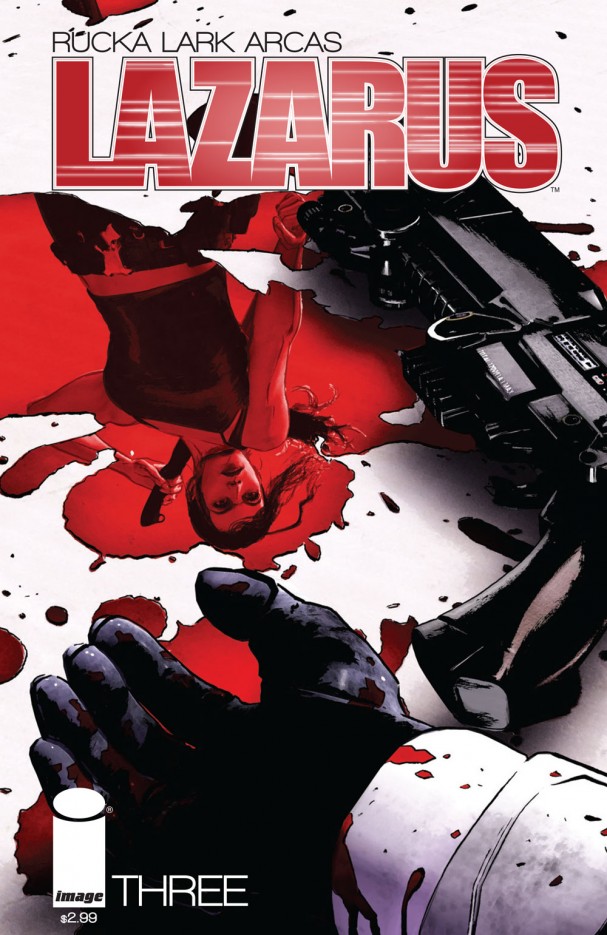 One of the principle issues with fascinating Lazarus is that it has been almost too cool for its own good, keeping the reader at an emotional distance as it laid out the rules of its world. In this issue, however, family enforcer Forever is sent to Mexico to meet a rival family and broker a deal, and she meets up with another of her kind of the first time in years. They recognise in each other kindred spirits, and through this relationship the cool facade finally cracks and raises the stakes by giving us something to hope for. The world of backstabbing and intrigue has seen peril at every turn, and now the threat seems tangible as Forever has something to lose. We getting a better sense of how the Lazarus caste are treated as ‘others’, and Rucka’s skill is in flipping from badass action to heartbreaking drama in a matter of panels. Lark’s art is so photographic that there are times it seems as though he has rotoscoped a high-definition drama and transplanted it onto the comic book page. Lazarus is an increasingly rich and complex tale that has rewarded our patience, and it will be fascinating to watch these characters flourish.
One of the principle issues with fascinating Lazarus is that it has been almost too cool for its own good, keeping the reader at an emotional distance as it laid out the rules of its world. In this issue, however, family enforcer Forever is sent to Mexico to meet a rival family and broker a deal, and she meets up with another of her kind of the first time in years. They recognise in each other kindred spirits, and through this relationship the cool facade finally cracks and raises the stakes by giving us something to hope for. The world of backstabbing and intrigue has seen peril at every turn, and now the threat seems tangible as Forever has something to lose. We getting a better sense of how the Lazarus caste are treated as ‘others’, and Rucka’s skill is in flipping from badass action to heartbreaking drama in a matter of panels. Lark’s art is so photographic that there are times it seems as though he has rotoscoped a high-definition drama and transplanted it onto the comic book page. Lazarus is an increasingly rich and complex tale that has rewarded our patience, and it will be fascinating to watch these characters flourish.
New Avengers #9 – Marvel, Jonathan Hickman (writer), Mike Deodato, Frank Martin (artists). Rating: 8/10
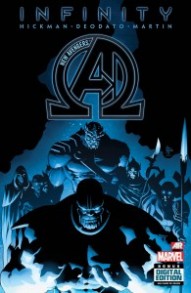 There might be a problem when things are already a bit confusing by the second main tie-in issue with Jonathan Hickman’s Infinity, but this issue does focus on the far more interesting aspects of the Infinity crisis. As Thanos dispatches his forces towards Earth, the various members of the Black Order seek out the remaining Infinity gem from the Illuminati. That familiar sense of being at least three steps behind the game creeps in regularly, especially if the Atlantean/Wakandian war has been a blip on your radar, and as the issue lurches from one scene to the next, you’ll find yourself reaching into your own deep recesses to recall all the pertinent information at each shift. “Infinity” is in no way pretending to be an isolated event, tying itself to the very fabric of the Marvel universe, so new readers will be up the proverbial creek without a longbox of back-issues. Yet the internal narrative of New Avengers has always been stronger than its stablemate Avengers, focusing on character and the cumulative effects of power and secrets. The lack of context around the Black Order, shy of a explanatory page at the page, is perhaps the biggest quibble, but it is hard to have any issues with Mike Deodato’s gorgeous art. It’s the ground-level characterisation that marks this part of “Infinity” as a successor to “Annihilation”, it would just be nice if the required reading wasn’t as expansive as the scope of the crossover.
There might be a problem when things are already a bit confusing by the second main tie-in issue with Jonathan Hickman’s Infinity, but this issue does focus on the far more interesting aspects of the Infinity crisis. As Thanos dispatches his forces towards Earth, the various members of the Black Order seek out the remaining Infinity gem from the Illuminati. That familiar sense of being at least three steps behind the game creeps in regularly, especially if the Atlantean/Wakandian war has been a blip on your radar, and as the issue lurches from one scene to the next, you’ll find yourself reaching into your own deep recesses to recall all the pertinent information at each shift. “Infinity” is in no way pretending to be an isolated event, tying itself to the very fabric of the Marvel universe, so new readers will be up the proverbial creek without a longbox of back-issues. Yet the internal narrative of New Avengers has always been stronger than its stablemate Avengers, focusing on character and the cumulative effects of power and secrets. The lack of context around the Black Order, shy of a explanatory page at the page, is perhaps the biggest quibble, but it is hard to have any issues with Mike Deodato’s gorgeous art. It’s the ground-level characterisation that marks this part of “Infinity” as a successor to “Annihilation”, it would just be nice if the required reading wasn’t as expansive as the scope of the crossover.
Sex #6 – Image Comics, Joe Casey (wrtier), Piotr Kowalski (artist). Rating: 8/10
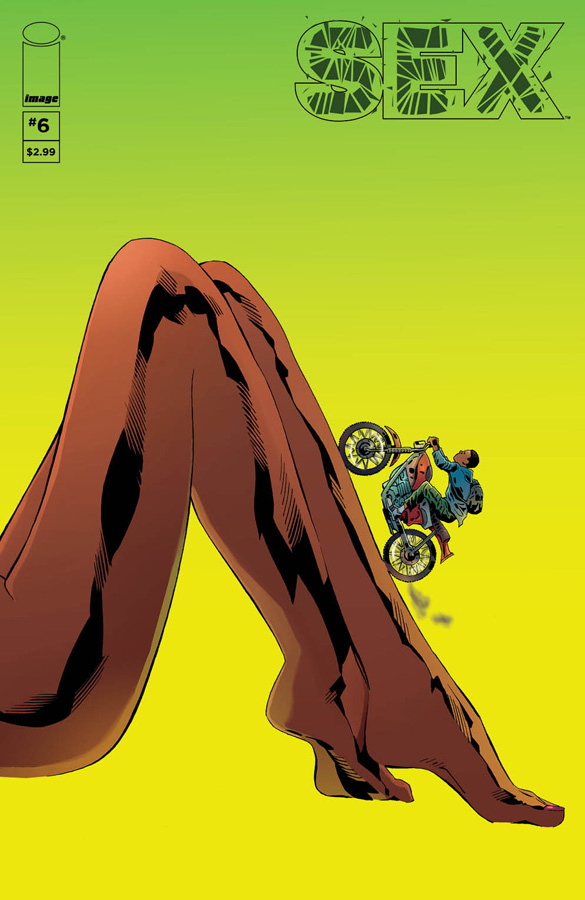 Just at the point that even the most insatiable of readers would be wondering if this book was going to offer anything more than mood punctuated by sex, Casey offers up a mostly story-based issue that delves into the business dealings of former costumed hero Simon Cooke. We learn more about Saturn City, a virtual analogue for New York or the distinguished competition’s Gotham, and that there is more to Annabelle LaGravenese than meets her (gradually failing) eyes. When Casey does use sex as a plot device, he curious shies away from any graphic depictions of a homosexual rape, perhaps feeling that is one taboo comic readers are yet to cross with him. A parallel scene of Keenan Wade performing cunnilingus on his partner is slightly more graphic, yet also tender and in keeping with the more low-key attitude of this issue. Indeed, that seem almost seems like an afterthought, with even Casey perhaps wanting to break free of his own motif and explore this world a little more. Kowalski appears to relish the chance to explore something other than the seedy bars and strip clubs of the city, opening with a stunning waterfront shot of the city, and cutting loose at the harbour and in more upmarket locations. Casey reminds us with this issue why this book is about exploring drama through sex, and not the other way around, and why that is uniquely fascinating.
Just at the point that even the most insatiable of readers would be wondering if this book was going to offer anything more than mood punctuated by sex, Casey offers up a mostly story-based issue that delves into the business dealings of former costumed hero Simon Cooke. We learn more about Saturn City, a virtual analogue for New York or the distinguished competition’s Gotham, and that there is more to Annabelle LaGravenese than meets her (gradually failing) eyes. When Casey does use sex as a plot device, he curious shies away from any graphic depictions of a homosexual rape, perhaps feeling that is one taboo comic readers are yet to cross with him. A parallel scene of Keenan Wade performing cunnilingus on his partner is slightly more graphic, yet also tender and in keeping with the more low-key attitude of this issue. Indeed, that seem almost seems like an afterthought, with even Casey perhaps wanting to break free of his own motif and explore this world a little more. Kowalski appears to relish the chance to explore something other than the seedy bars and strip clubs of the city, opening with a stunning waterfront shot of the city, and cutting loose at the harbour and in more upmarket locations. Casey reminds us with this issue why this book is about exploring drama through sex, and not the other way around, and why that is uniquely fascinating.
Thanos Rising #5 (of 5) – Marvel, Jason Aaron (writer), Simone Bianchi (artist). Rating: 7/10
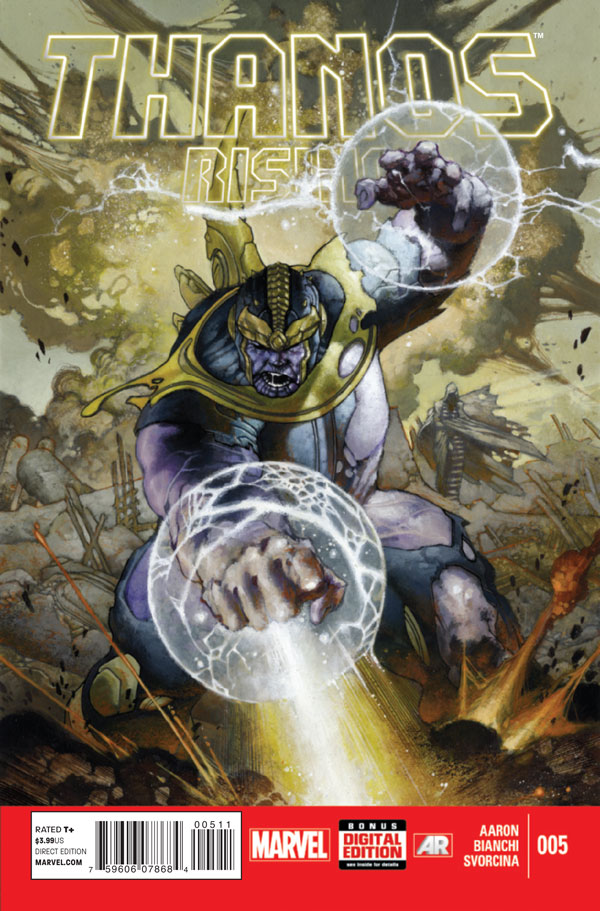 After a less than spectacular start, Jason Aaron’s Thanos Rising has incrementally improved as it recounts the tragic tale of a man led astray by a woman. Steering away from the obvious misogyny/religious implication of that, the last few issues have posited the notion that Thanos was merely misguided in his attempt to appease his ‘one true love’, and instead committed mass murder to appease a figment of his own diseased mind. The courtship of Thanos and Death is one of the great romances of the Marvel cosmic universe, and it is through her that Thanos transitions from mad bastard to being a god. This new information that it may all be in his head, or that there was ever a moment of doubt, is a double-edged sword: it adds a new layer to his character, but it also diminishes his power somewhat. Bianchi’s art, on the other hand, is gorgeous. Coupled with inks and inkwash from Riccardo Pieruccini, there are some stunning pages, especially the one in which Thanos finally shares Death’s cold embrace. In a well-timed bit of synergy, this issue comes in the middle of “Infinity”, but so far there are few connections to be found.
After a less than spectacular start, Jason Aaron’s Thanos Rising has incrementally improved as it recounts the tragic tale of a man led astray by a woman. Steering away from the obvious misogyny/religious implication of that, the last few issues have posited the notion that Thanos was merely misguided in his attempt to appease his ‘one true love’, and instead committed mass murder to appease a figment of his own diseased mind. The courtship of Thanos and Death is one of the great romances of the Marvel cosmic universe, and it is through her that Thanos transitions from mad bastard to being a god. This new information that it may all be in his head, or that there was ever a moment of doubt, is a double-edged sword: it adds a new layer to his character, but it also diminishes his power somewhat. Bianchi’s art, on the other hand, is gorgeous. Coupled with inks and inkwash from Riccardo Pieruccini, there are some stunning pages, especially the one in which Thanos finally shares Death’s cold embrace. In a well-timed bit of synergy, this issue comes in the middle of “Infinity”, but so far there are few connections to be found.
Agree or disagree? Got a comment? Start a conversation below, or take it with you on Behind the Panel’s Facebook and Twitter!
If you are an iTunes user, subscribe to our weekly podcast free here and please leave us feedback.

